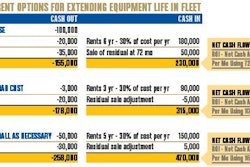After reading editor Becky Schultz’s Breaking Ground editorial column titled “5 ‘Truths’ Destined to Impact Your Construction Business”, I had to contact her to compliment her on a very well written piece that summarized the five issues contractors are in the process of dealing with — or soon will be — to remain competitive and profitable. If you did not read the column, go back and do so because it is certainly an outline for your management team, whether you have a crew of 10 or a crew of 10,000.
The five truths listed were:
- Technology adoption will be essential to success.
- Equipment is becoming more complex.
- Jobsites will become more mechanized.
- Efficient data management is crucial.
- Education and training are a must to stay in the game.
Just reviewing this list lets you know you are in for a lot of education, training and investment in technology. And it may even appear reasonable and doable. But if you go back and read Becky’s column where she dives into the weeds a bit, you come away with a very different feeling that there is a lot more here than you expect.
I agree that these five truths are in play. I also submit that every contractor will have to comply to some degree with each of the five truths because of project/client demands.
I guess the question for every contractor out there will be “How do I implement these changes without messing it up?”
It’s a good question that needs some discussion to avoid making investments that do not provide meaningful ROI.
No matter the size of your company, you will need to draft a plan covering at least a five-year period, which lists objectives, cost estimates and a timeline for implementation, along with accountability assigned to each person involved. Don’t scare yourself, but be prepared to come up with an outline after a discussion with your management team (or spouse) of the steps you need to take and the resources you need to draft a doable program.
After reading Becky’s column the first time, I thought the internal resources required to meet these requirements would be quite substantial. I suspect the national contractors could implement these programs with ease, but what about the rest of you — because we all need to get more efficient to stay competitive.
Here is how I would proceed to meet the future needs of the industry.
Deal with Truth #5 First
There is education to be had from OEMs, equipment dealers, rental companies, industry associations, performance group participation, business system providers, publications, conventions, online courses, etc.
Somebody in your company has to “know” the industry and that person should determine what education is necessary and who should get it. If you need further help with this, your equipment dealer can provide industry data and sources of information. Your accountant (if they have industry expertise) can also help out. If you use an industry specific system, the system provider usually knows what is going on in the industry and how certain issues are being handled by other companies.
The bottom line is you can cut to the chase and find out what you need to do to manage and operate a contracting firm of the future by finding the “experts” in your area and calling on them for some input.
Tackle Truth #1 Next
Dealing with all forms of technology is a must. I have to admit that people under 30 have the best chance of providing you with the ability to properly use your systems and other apps to make you competitive.
There are a lot of “technology experts” out there looking for jobs. Most graduated with a degree that does not guarantee a job in their chosen field, but who are experts when it comes to dealing with technology.
Check your basement; you may have a son or daughter down there who fits your need. If you find one who can set up your laptops, tablets and other digital equipment, plus train your staff how to properly use this equipment, you have found yourself a keeper that you can develop into an industry person. Plus, they can now become a tax-paying member of society.
Telematics Will Save You Time and Money
Telematics provide data and information that make you money. You can try to decipher the data you get, or better yet, have your equipment dealer do it for you. I consider this similar to a visit to the car dealer service department. They give me the list of what they think needs to be done and I decide which items to have them service.
There is no doubt there is a learning curve here, but eventually you will learn how to prioritize what the machines are telling you.
On to #2 and #3
Your equipment dealers and rental companies should be educating you about the complexity of today’s equipment. In fact, you can outsource this problem by renting the “complex” equipment, leaving the problem with the rental company.
So there you have it — a program or approach on how to implement the five truths and for a very modest investment. Use industry sources for education. Use OEMs, dealers and rental companies to help with equipment needs. Find a part-time or full-time person comfortable with technology you can hire for a modest sum.
Your individual investment on the front end is to develop a plan of what you want your firm to look like five years from now, along with an estimate of the investment required. The point here is that you can do this, no matter what size company you have, and you have to do this because the times they are changing.




















